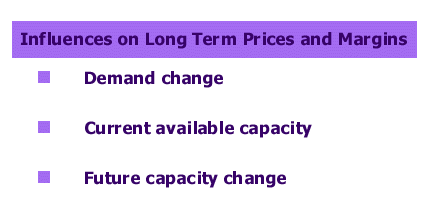BASIC STRATEGY GUIDE: STEP 19
Activity Three: Develop a pricing policy to improve the Company’s market share and returns. Prices never seem to be simple or stable. Most markets press you to change your price. You need a pricing policy to govern your Company’s actions when it faces these pressures. This activity develops that pricing policy. It helps you anticipate the pricing pressures you may face by helping you understand the likely direction of your market’s future long and short term prices. It then looks for opportunities to change your prices compared to those of your competition to increase your profits or your market share. You change your prices by adjusting the process you use to develop a price for each product and customer. You implement specific price changes by changing the components you use to create the price.
Step 19: Project the direction of future prices and margins

What:
Evaluate the balance between future demand and the capacity of the industry in order to predict the direction of future prices and margins.
If the total of the Company’s sales, general and administrative expenses is at or below 10% of sales, the Company should make an explicit forecast of demand growth and future capacity. This effort predicts likely future prices. If, on the other hand, sales, general, and administrative expenses exceed 10% of sales, then the Company should evaluate the likely growth of capacity compared to demand. This effort predicts likely direction of prices and margins.
Why:
The Company needs a good understanding of the price outlook in the industry in order to develop an effective pricing policy and to set reasonable investment plans. In a falling price environment, the Company will need to be more flexible in its approach to pricing. If the fall in prices results in lower margins, the Company might also reduce its planned investment in the industry. In a rising price environment, the Company may be more aggressive and firmer in its application of pricing rules. If these rising prices bring increased margins, the Company might step up its investment program in order to insure itself of the capacity to meet all the needs of its Core customers.
What to Watch For:
-
The Company should do a detailed forecast of prices if it is a low value-added industry. Otherwise, it should focus on potential new entrants and the expansion of low cost competition.
-
The industry’s potential high cost competitors set the price. The price is the cash costs of the next increment of capacity to come in to the market.
-
In a market with growing demand, the type of new capacity required drives minimum pricing. Where demand shrinks, the industry price drives the maximum capacity in operation.
-
Even in the most Hostile markets, industry capacity may often grow due to Capacity Creep and to debottlenecking investments.
-
Industry consolidation usually increases rather than decreases the pressure on industry margins.
-
These forces tend to increase prices and margins:
-
There is an unforeseen surge in customer orders
-
The industry cannot obtain critical components or raw materials
-
The industry’s excess capacity is falling quickly
-
Competitors in the market consolidate to the point that no more than four companies control 85% of industry volume
-
-
These forces tend to decrease prices and margins:
-
Industry demand is falling
-
Current competitors are adding capacity faster than demand is growing
-
Real price increases (that is, price increases over inflation) have occurred consistently in the industry over the last few years
-
New competitors enter the market, attracted by its high profits or high growth
-
Competitors begin offering a low-price point product
-
Action:
Modify the aggressiveness of the Company’s investment program and adjust its sensitivity to competitive price moves depending on the direction of future prices. If prices and margins are likely to go down, the Company might reduce its capital spending and increase its vigilance on competitive price moves. It would adopt more defensive pricing tactics. If prices and margins are likely to rise, it might adopt more offensive pricing tactics.
-
Self Test #19: Project the Direction of Future Prices and Margins
-
Worksheet #19: Project the Direction of Future Prices and Margins
More Information on Industry Price Outlook on the Advanced Site >>
For helpful context on this step:
Videos:
Perspectives:
Symptoms and Implications:
